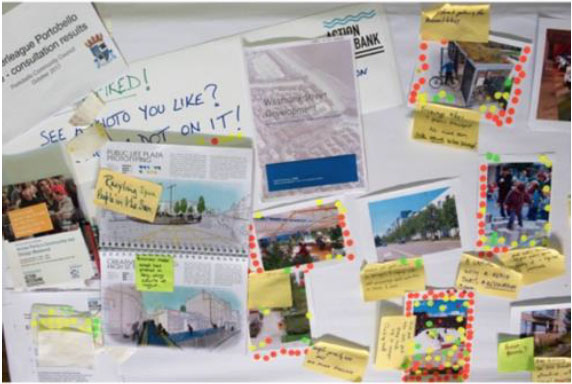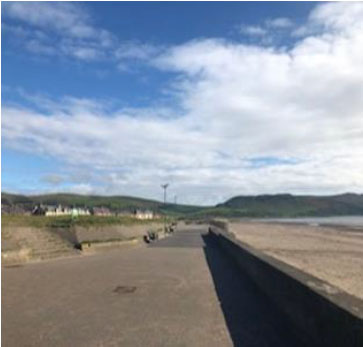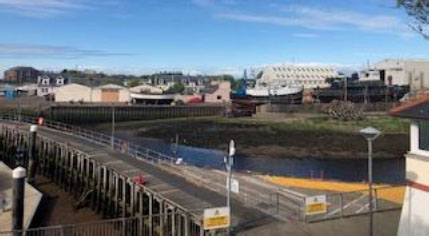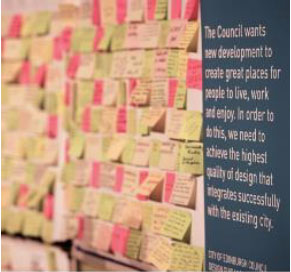Community-led design initiatives: evaluation
Findings from an evaluation of community–led design initiatives funded by the Scottish Government: the Charrette Mainstreaming Programme and the Making Places initiative.
4. Impact and outcomes
All projects funded through the Programme were required to submit a final report to Scottish Government, and all have done so to date. These reports were an important output of the process in each area and usually described the design event process, priorities agreed by the community, and some form of action plan for taking these forward.
Contributions from the community, Portobello Charrette

Photo credit: Action Westbank Team
However, communities have also continued to be active in delivering on priorities set within these reports, and this chapter describes the range of short and longer-term outcomes arising from design events funded through the Programme as reported by research participants. The evaluation aims to establish the impact of community-led design processes on those involved – including the community of that area, local organisations, and other stakeholders in the process, and these are reported in this chapter.
The outcomes identified are grouped thematically, and give a flavour of the range and extent of impact of the sample projects examined. This chapter focuses on community empowerment; short-term outcomes of the design processes; infrastructure; partnership working and decision making; ongoing local engagement; local knowledge and capacity; and outcomes with regards to funding.
4.1 Extent of impact
The extent of impact varies across the sample projects. Short-term impact can be evidenced to some degree across all of the sample projects examined, however, the initial flurry of activity and energy generated by the design events was not always sustained. Some of the sample projects have been successful in continuing to deliver impact over the longer term. In other areas, despite initial enthusiasm, follow-through has been weaker and there has been less impact as a result.
"We had an 18-month action plan which is continually updated. Most of it has been delivered." (Local authority)
"The design event report doesn't play any role. Nobody has been driving it forward." (Local stakeholder)
Most of the sample projects achieved a mix of short and longer-term outcomes. Usually this was intentional, with areas recognising the importance of quick wins to maintain community interest, combined with longer-term outcomes that can deliver more substantive impact. Frequently, research participants were of the view that either outcomes would not have materialised had the design event not taken place or that outcomes would have happened more slowly.
Areas rich in local assets, namely a concentration of local people with pre-existing knowledge and understanding of how and where to access funding, were most successful in achieving long-term impact. Where there was less of this local capacity, impact was reported to have been more limited.
4.2 Community empowerment
Across all of the sample projects, research participants were universally positive about their experiences of taking part in the design events. They described having enjoyed taking part, felt they had been well facilitated and had left feeling more engaged and empowered.
"The charrette got to grips with the key issues, through its intensity of focus, and in allowing the community to open a dialogue with a team of experts. It also managed people's expectations in terms of affordability and practicality." (Stakeholder)
"An extremely positive community exercise. There had been lots of previous attempts along more traditional lines – experts had been parachuted in to implement change in the community. These had been consistently unsuccessful, as the ideas presented had belonged to the experts and the consultants – not to the community. Here, people really did engage enthusiastically. They very quickly took ownership of the event and its processes." (Member of the community)
"A proper community led event, as opposed to a few folk in a room making decisions which affect the whole community." (Member of the community)
"Let's give this a try. It can't be allowed to be the next thing that's failed in our area." (Member of the community)
In the short-term, the design events seem to have been successful in galvanising community spirit and generating support for a shared vision for the area. Participants at design events described a positive energy and enthusiasm that inspired the community, but it was the ability to take actions and drive changes forward post-event that seems to have empowered or disempowered the community longer-term.
"The charrette empowered the community to believe it can influence decisions – this is good for democratic participation, and for people's own empowerment." (Local authority)
"The process has given people confidence that they have power and influence that they didn't realise, but there is no easy formula for getting voices heard." (Member of the community)
"Even if the outcome of the charrette had been unsuccessful, the community would have been in a better place – more empowered, greater capacity etc. The social dimension can change – there can be a change of mindset." (Community volunteer)
"It cemented the community's belief that they could make things happen and led to more discussion about community ownership of assets. It gave them confidence." (Public body)
"The charrette stopped a very difficult conversation being difficult." (Local authority)
"The local authority had committed to place-making but weren't really doing it. The charrette was a good example of how it could be done." (Local authority)
Some projects successfully capitalised on the energy created by the design events and were able to build on this longer term. In some areas, however, the design event process was far less successful at engaging the community longer-term.
"Charrettes are good enablers for community groups, but you need drive alongside it. That didn't happen in our area." (Member of the community)
"You can't create a community – it has to evolve. In our area, people were initially enthusiastic but that waned really quickly." (Community volunteer)
"Paid staff can act as gatekeepers to the local community. Often there are local people who are willing to be involved – but because the local authority has worked the way it has for many years, local people perhaps don't get the opportunity to be involved more extensively." (Community volunteer)
4.3 Short-term outcomes
Many research participants spoke of the importance of short-term outcomes, or what they frequently referred to as "quick wins", to ensure that the community remains engaged and has faith that the process is delivering results. Quick wins keep awareness of progress in delivering design event priorities high, and give a clear message to the community that they have been listened to.
Girvan landscape
Photo credit: Blake Stevenson

In one of the sample projects, for example, a community art event created a hugely popular quick win, transforming an unsightly and unpopular concrete underpass into an exciting colourful entrance. This simple enhancement was achieved within three weeks of the project's inception, demonstrating to the community that the design event process could actually make things happen. It became a much talked about symbol of success and resulted in enhanced levels of community involvement and optimism. The ultimate message as one stakeholder explained, was:
"… that this is not just a talking shop – we're going to get things done here" (Stakeholder)
In another of the sample projects, an enterprise support hub was created, with a pop-up shop within a former bank building in the town's high street which again demonstrated the success of the project in a visible, tangible way. It enabled local people to share their ideas and ambitions collectively in a place they felt belonged to them. In another example, a project was established to interpret and promote the medieval/market-place heritage of a particular street in the town.
In one project, stakeholders described the selection of the host venue for the design event event itself as a subtle quick win. The former community library had been recently closed following a local authority budgetary review. They felt that the choice of this venue, right at the heart of the subject area, demonstrated the potential for positive change. They also noted that it had the added benefit of making the community feel comfortable in a place that they felt had always belonged to them.
Research participants understood that not all successes can be achieved quickly. However, where progress is likely to be slower, research participants emphasised the importance of effective feedback mechanisms for the community so that they understand that while progress is not visible, this does not mean that there will be no change in the long-term. Without this feedback, some research participants reported that people were left feeling like their expectations had not been met.
Slow progress led to frustration for many, and resulted in a loss of goodwill. In some areas, momentum created by the design event process was lost as a result and consequently, in these areas, the longer-term impact of the design event process has also been more limited, due to a lack of capacity or enthusiasm for change.
"The process became long and drawn out, and the decision kept being deferred by the Committee in the local authority. That was tricky – people lose motivation, and you lose the goodwill from the people involved. You also lose the positivity and energy gained at the event. (Community organisation)"
"It has dragged since the charrette due to the council being stretched." (Community organisation)
"The participation request has still not been signed off by the local authority – they have reverted to the "Council time zone". Citizens struggle with this!" (Community organisation)
Ensuring realistic expectations at the outset, and ensuring sufficient focus on both short and longer-term outcomes, were also recognised by research participants to be important components of successfully achieving impact.
4.4 Local infrastructure
4.4.1 Creation of new local groups/local structures
Some areas set up new groups specifically tasked with taking forward actions from the design event. Examples include:
- The Town Team in Girvan
- Macedonia Action Group in Glenrothes
- Go Forth Kincardine
- Bute Island Alliance
- Aspire Arbroath
- Pollokshields Heritage Trust
- Charrette Champions' Group in Arbroath
- Community Connectors in Arbroath
In the projects included in the study sample, these new groups had varying degrees of success in driving forward some of the quick wins referred to above. While these dedicated organisations can be helpful drivers in the early stages post-design event, enabling focus to be placed on delivering priorities agreed during the design event, this success can be short-lived. Some of the groups reportedly remain active and are focused on delivering the priorities set by the design events. However, others have folded, lost focus on these priorities with the passage of time, or have undergone a change in their remit.
4.4.2 Physical infrastructure
There have been significant physical outputs resulting from priorities agreed during the design event process. These have been varied and have been a very visible way of demonstrating to communities that change is happening as a result of design events, with many of these outcomes being a direct result of priorities agreed through the design events. They range from small-scale, short-term changes that positively impact the "look" of local places, to more major and longer-term infrastructure projects.
There are a large number of short-term initiatives which have come out of the design event process. These varied significantly from place to place and are testament to the commitment of the local communities involved. Some of the examples cited by research participants are listed below:
- a street market now taking place once a month in a participating town
- the introduction of more Men's Sheds in an area, mostly located in former local authority buildings
- sourcing funding for bunting and painting old bikes and planting flowers in their baskets to decorate one part of a town centre – which was among improvements which led to full occupancy of shop units in that area
- a well-being centre established within a local park which will be used by the local cycle club as a base, and out of which a bike-borrowing service will be run
- new signage being installed in a town centre
- water fountains established in town centre
- local shop fronts painted to make the High Street more attractive and encourage in new businesses (although not without a protracted process of planning permission)
- a community art event was held which transformed an unsightly and unpopular concrete underpass into an exciting colourful entrance
- launch of a destination website for one local area
View in Girvan
Photo credit: Blake Stevenson

4.4.3 Longer-term infrastructure change
Some of the infrastructure changes delivered as a result of priorities set through the design event processes required more lead-in time and in some cases were not achieved until months or years after the original design event had taken place. In areas where feedback to the community had been effective, research participants were still able to draw a direct line of attribution back to the design event process. Some examples of this longer-term impact of the design events included:
- a hydro scheme was installed in one area and while research participants clarified that this was not an explicit output listed in the design event report, it was described as having been "spurred on" by the design event
- a dual carriageway in one area is in the process of being converted into single carriageway through the town centre. This process has required multiple stages of funding to take them from conception to design and is now moving towards implementation. Research participants felt that this would not have happened had it not been set as a priority through the design event
- a new pedestrian and vehicle bridge is being progressed in one area – this is a long-term project, but its conception was a direct result of priorities agreed through the design event
- in another area, they refurbished a local historical landmark which is scheduled to re-open in 2019 with a cultural hub as a welcome point for visitors
- in one area, local volunteers are in the process of negotiations with the council. The Council Committee has instructed council officers and the community to work together to develop a masterplan for the site (that was the subject of the design event) to replace the plans which were in place prior to the design event. They are hopeful that this will influence how the authority approaches similar processes in future
- active travel links being developed in conjunction with Sustrans and one of the local authority areas examined
- one area built a hostel that now generates its own income – members of the community indicated that the design event process was instrumental in encouraging local people to lead on projects of this nature and scale
- involving local landowners in the design event process in one area has resulted in a site being made available for 50 affordable homes. Research participants noted that this would not have been achieved without the impetus from the design event
- an enterprise support hub was created, with a pop-up shop within a former bank building in a High Street
- established self-guided walking routes supported by technology
- in one area, a townscape heritage Wayfinding and Public Realm project has been successfully implemented
- in another area, creative industries touchdown space has been established within the local library and gallery in partnership with the local Cultural Trust
- innovation workshops have been held in one area to encourage businesses to leverage heritage tourism opportunity
Many of these longer-term infrastructure projects are highly visible and tangible, and they were often helpful in demonstrating to the community that public bodies had listened and acted on priorities set through design event processes.
4.5 Audits and feasibility studies
Various audits and feasibility studies have been conducted in response to priorities set by design events. These include an audit of accessibility in one area, and a feasibility study into the narrowing of a road from a dual to single carriageway. These audits and studies have led to some of the physical infrastructure projects described above.
4.6 Partnership working and local decision making
Participants in most of the areas examined described significant improvements to local partnership working, and more effective and joined-up decision-making processes.
"The charrette helped a variety of agencies to work together better. It has improved communication in our area." (Stakeholder)
Some also described local stakeholders being more engaged and proactive since the design event. Significantly, some areas also described more effective local decision-making processes as a result of the design events, including improved decision-making across community planning, for example:
- strengthened community planning within one local authority which has had an impact beyond the local area
- in another area, the council has changed its approach to assets more generally
- in one area, the community engagement processes trialled through the design event have been embedded in planning processes since the design event
- in one area, working partnerships have now been established between Scottish Canals, Highland and Islands Enterprise (HIE), Sustrans and Scottish Natural Heritage to deliver the outcomes of the design event
- in another area, the Bute Island Alliance has established improved partnership working with HIE, Argyll and Bute Council, SURF and Mount Stuart Trust
However, this type of progress did not occur in all of the sample project areas, and some research participants in these areas considered this to be a missed opportunity to capitalise on the momentum created by the design event.
4.7 Local engagement
In some areas, local engagement has also improved since the design events took place. Some projects described local people becoming more involved in local action (for example, a member of the public at one design event was inspired to go on to become a local councillor). In one area, stakeholders reported that community groups are more engaged with young people than they were previously and now understand better how to engage with them meaningfully. In another area, membership of local groups had increased significantly since the design event.
Some areas also described local authorities and other larger public bodies using the design event process to gain a better understanding of how best to engage with the public on planning issues – and changing their wider approach to it as a result.
Community participation in the design process, Portobello charrette

Photo credit: Action Westbank Team
4.8 Local knowledge and capacity
Some of the sample projects were located in areas that were already rich in local resources i.e. with committed, active communities with expertise, knowledge and motivation to improve their local area. Other areas had fewer of these assets available within their communities. In both sets of circumstances, research participants fed back that the design event process had improved local knowledge, capacity and confidence and saw this as a significant outcome of the design event process. In one area, for example, a group of secondary school pupils who participated in the design event were engaged by the local authority planning department to participate in a further project. This project sought their contributions in helping to identify opportunities for the community in the formulation of future Local Plans.
"Building capacity of the community is as important as the actual intended outcomes." (Stakeholder)
"The charrette process has helped us to grow community knowledge of the costs of projects, the complexities of maintenance etc." (Member of the community)
However, some areas remain better placed than others in relation to knowledge, expertise and confidence, and while the design event process may have supported some development in this respect, there are areas that remain in need of support to drive forward change.
"There remains a need to develop communities' capacity to understand where the funding opportunities are, and what is involved in applying for and delivering projects." (Community organisation)
4.9 Additional funding
The design event process has led to substantive funding being attracted into some of the sample project areas. They have given local areas improved intelligence about priorities for the area, and have also given some funders a "short-cut" to knowing how best to use available funding in some areas. The examples below are only a snapshot provided by some of the sample projects, but they give a sense of the scale of funding that has been attracted in to some areas:
- in one area, a City Deal application focusing on physical infrastructure is bringing significant funding to the area. The bid was directly informed by priorities outlined in the community-led design event report.
- a Landscape Partnership bid was submitted to support the wider vision for heritage work in one area. The design event report informed this bid which attracted some £2 million from Heritage Lottery Fund for a landscaping project.
- a follow-up process which involved developing a design guide and options for the main town square in one area resulted in some £120,000 of external funding being made available to take the work forward.
- in one area, a successful application was made to Sustrans to undertake an accessibility study into connections around the town. This helped the area to build a case for more significant levels of funding.
- funding to enable construction work to begin on a major route through a town centre (reducing it from dual to single carriageway) was informed by consultation and exploration of solutions with the community during the community-led design process.
- £1.5 million funding has been provided by a local authority for work to a local community centre as a direct result of consultation undertaken during the community-led design process.
- £10,000 funding contribution from a local trust, combined with £2.25 million from a range of other funders, including Heritage Lottery Fund, has contributed to the implementation of a townscape heritage wayfaring and public realm project.
- £2m funding leveraged for an outdoor hub project, including improvements to the quality of a local towpath.
- in another area, delivery partners have funded a project investigating a potential enterprise park on a decommissioned site which had been the subject of discussion at the community-led design event, and one of the original triggers for the process to take place.
Whilst it is not possible to determine whether this funding would have been attracted in to areas without the design event process, many of those interviewed were confident that it was additional.
Contact
There is a problem
Thanks for your feedback